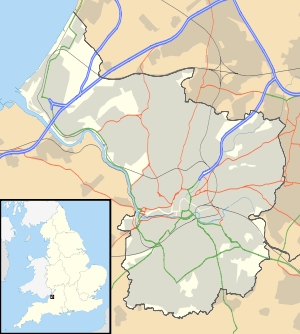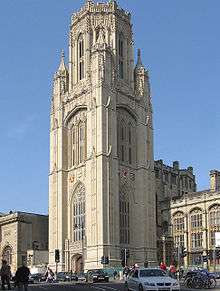University of Bristol Botanic Garden
The University of Bristol Botanic Garden is a botanical garden in Bristol, England. The garden moved to its current site in Stoke Bishop having previously been at two other sites in the city. The 4,500 species of plants are displayed in collections relating to evolution, Mediterranean, local flora and rare natives and finally useful plants.
| University of Bristol Botanic Garden | |
|---|---|
Metrosideros excelsa displayed as part of the pollination collection | |
 | |
| Type | Botanic Garden |
| Location | Bristol, England |
| Coordinates | 51.4777°N 2.6258°W |
| Area | 1.77 hectares (4.4 acres) |
| Operated by | University of Bristol |
History
The University of Bristol established a botanic garden in 1882 at Royal Fort House adjacent to Tyndall Avenue. It was laid out by Adolf Leipner.[1] This site was later known as the Hiatt Baker Garden.
In 1959 the site of the Botanic Garden was used to build the university's Senate House. The botanic collection was moved to the spacious gardens of Bracken Hill beside North Road, Leigh Woods, near the Clifton Suspension Bridge. The Bracken Hill house and gardens had been established in 1886 by Melville Wills, a noted benefactor to Bristol University.
Bracken Hill house and some of the gardens continued to be used by the plant pathology and other services of the government's National Agricultural Advisory Service (NAAS), advising farmers and growers from Herefordshire and Dorset to Lands End during and after World War II when UK-grown crops were vital to minimise rationing. See, for instance, the cereal and vegetable diseases work of Lawrence Ogilvie at Bracken Hill. The NAAS staff, laboratories and offices had moved there from the Long Ashton Research Station also to the west of Bristol.[2][3]
In 2005 the botanic collections were relocated to The Holmes, a site in Stoke Bishop opposite Churchill Hall. The Holmes had been built in 1879 and had a 1.77 hectares (4.4 acres) ornamental garden. It had been used by United States Army staff during the preparations for the Normandy landings during World War II.[4] The new garden designed by Land Use Consultants advised by Peter Crane, was the first University Botanic Garden built in the UK in the 21st century.
Various organised tours and visits are available along with some horticultural talks and courses.[5]
Displays
The garden has 640 square metres (6,900 sq ft) of greenhouses divided into cool, warm-temperate, sub-tropic and tropical zones which house plants from the evolution collection. The tropical zone includes a raised pool with aquatic plants including the water lily Victoria cruziana.[6][7][8]
The displays include 4500 plant species.[9] These are divided into collections of evolution, Mediterranean, local-flora, rare-native, and finally useful plants.[10] The useful-plant displays include herb gardens with western, Chinese and herbal medicine, including species used in Ayurvedic and Southern African medicine.[11] Displays of plants from the Mediterranean climate region include those from several continents.[12] Plant evolution is illustrated by several displays.[13]
The local-flora and rare-native collection includes the unusual species found in the Avon Gorge, Mendip Hills, Somerset Levels and surrounding areas.[14] These plants include the Bristol Onion, Cheddar Pink and various species of Whitebeam.[15]
The Botanic Garden, in partnership with the Arnolfini gallery, has created a floating ballast-seed garden on an old barge in Bristol Harbour.[16]
References
- "Origins of the University of Bristol Botanic Garden". University of Bristol. Retrieved 13 June 2015.
- "Bracken Hill". University of Bristol. Retrieved 13 June 2015.
- "The University of Bristol Botanic Garden at Bracken Hill". Bristol Video. Retrieved 13 June 2015.
- "Holmes". University of Bristol. Retrieved 13 June 2015.
- "University of Bristol Botanic Garden". Bristol Mag. Retrieved 13 June 2015.
- "Glasshouses". University of Bristol. Retrieved 13 June 2015.
- "University of Bristol Botanic Garden". Culture24. Retrieved 13 June 2015.
- "University of Bristol, Botanic Garden". Garden Visit. Retrieved 13 June 2015.
- "University of Bristol Botanic Garden". Visit Bristol. Retrieved 13 June 2015.
- "Plant Collections". University of Bristol. Retrieved 13 June 2015.
- "Useful Plants". University of Bristol. Retrieved 13 June 2015.
- "Mediterranean". University of Bristol. Retrieved 13 June 2015.
- "Evolution Collection". University of Bristol. Retrieved 13 June 2015.
- "University of Bristol Botanic Garden". Royal Horticultural Society. Retrieved 13 June 2015.
- "Local Flora and Rare Native Collection". University of Bristol. Retrieved 13 June 2015.
- "Tours on the floating garden of Bristol harbour". University of Bristol. Retrieved 13 June 2015.
External links
| Wikimedia Commons has media related to University of Bristol Botanic Garden. |
